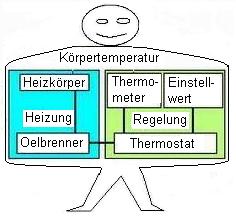| Hypercommunication - Crash Courses - Second-order Systems Theory [ Hyper-Library ] [ Hyper-Lexicon ] [ back ] |
|
|
backward - Page 17 - forward |
|
When explaining phenomena, I use a recursive procedure in which the phenomenon is first described in an appropriate way. Then I construct a mechanism by means of which the phenomenon can be produced and thus "understood". Then I derive further aspects of the phenomenon from the mechanism and check whether these new aspects are also present in the phenomenon to be explained. In doing so, the phenomenon changes and the explanation process begins anew. |
1. description of a phenomenon
|
In systems theory, the procedure as a whole, or its middle part, is also called modelling (for example, R. Hirsig ((1993:1.2f)). H. Maturana (1984:34f) calls this procedure in its linguistically lax manner an explanatory system or explanation of recognition, although it is not a system but a procedure that leads to a description (note 1). H. Maturana thus makes a linguistic shortening which is also reflected in his expression "autopoietic machine". In his formulations, the living being is a (albeit special, autopietic) mechanism. In my more explicit way of speaking, I do not say anything about the living being, but something about the mechanism I use to explain a phenomenon (note 2).
|
Of course, I can always ask myself which phenomena fit to a given system. Thereby I invert the problem definition. For example, once I have explained the constant room temperature in my living room, I can consider where comparable phenomena occur. Because constructive explanations are fictitious in the true sense of the word, because the construction "explains" the phenomenon created by the construction, I can search for different phenomena for each explanation. In particular, I can also ask for the explanation of a phenomenon which I do not assume to be produced by a machine. For example, I can ask myself how I keep my body temperature constant near 37 degrees. I can also explain such questions on the basis of mechanisms, whereby I then explain how the explanatory mechanism works and theoretically justify to what extent the mechanism represents the operations essential to the phenomenon. For example, I explain how a thermostat-controlled heater works and what the heater theoretically has in common with my body. Then the explanation is fictitious in the sense that it is constructed on the one hand and assumed on the other hand. |

|
A certain generalization of this inversion leads to the fact, that I construct complex systems independent from phenomena, which I assume can explain a lot of different phenomena. I use this generalization - which is of course also the sense of systems theory - when I use systems theory a priori - i.e. when I do not derive the (systems) theoretical approach from the object of investigation (note 3).
This a priori obviously has nothing to do with that of the philosophical I. Kant (or would be the opposite).
|
Give an example of how further hypotheses are derived in this procedure. |
|
Examples:
|
I will explain later, how system theory does not have a general form, but becomes general by inversions - so general, that quite different, among each other seemingly unrelated approaches are called "system theory" (note 4). So, first of all, I consciously deal with the "cybernetic" side of inversion of inversion of inversion of inversion ... And even on this side of inversion I use inversions.
|
|
backward - Page 17 - forward |